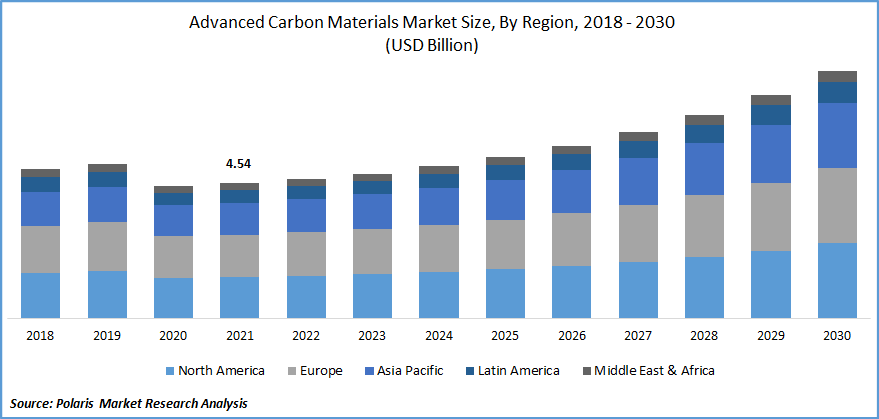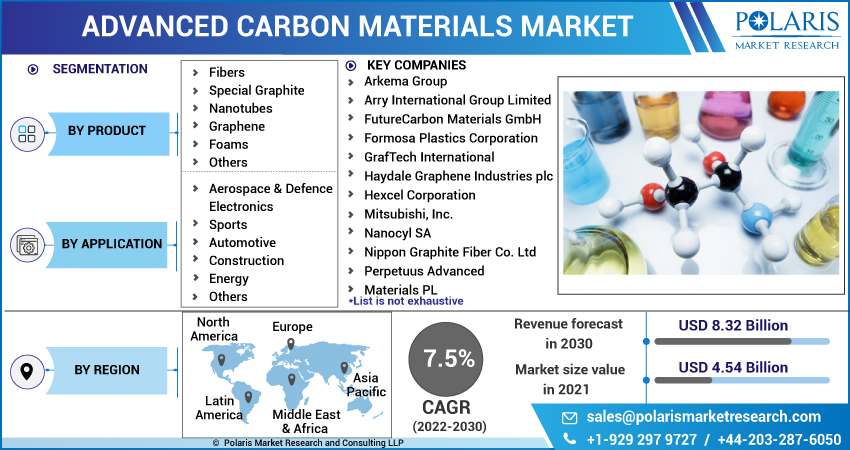
Advanced Carbon Materials Market Share, Size, Trends, Industry Analysis Report, By Product Type (Graphene, Carbon Fibers, Special Graphite, Carbon Nanotubes, Carbon Foams); By Application; By Region; Segment Forecast, 2022 - 2030
- Published Date:Jul-2022
- Pages: 118
- Format: PDF
- Report ID: PM1166
- Base Year: 2021
- Historical Data: 2018-2020
Report Outlook
The global advanced carbon materials market was valued at USD 4.54 billion in 2021 and is expected to grow at a CAGR of 7.5% during the forecast period. The rise that the need for carbon is primarily due to higher industrial applications, which is expected to boost market demand throughout the forecast period.

Know more about this report: Request for sample pages
In addition, rising spending by automobile firms such as Volkswagen and Ford on developing lightweight composites to induce fuel economy characteristics in completed products is likely to boost demand for this market throughout the forecast period.
Advanced products outperform typical varieties in heat durability and mechanical properties like tensile strength. The most commonly utilized advanced compounds as metallic elements are graphene, carbon fibers, structural graphite, and nano-tubes. Because of the aforementioned factors, the advanced carbon materials market is expected to rise. However, wastage in the production of completed products and the high related cost of carbon fiber composites are expected to restrain the advanced materials market growth during the forecast period.
The COVID-19 pandemic has impacted global imports and exports of several items. Different governments have imposed import sanctions, which have significantly impacted supplies. Advanced carbon product manufacturers frequently experience delays in getting raw products, which contributes to delayed customer delivery.
The quality of some raw materials has deteriorated dramatically, and the lack of vessel availability and blank sailing has severely impacted export orders, limiting the growth of the advanced carbon business. Because industries that require advanced carbon products for product manufacturing, such as automobiles and aviation, have been shut down, the adoption of advanced carbon has dropped dramatically, limiting market growth during the epidemic.

Know more about this report: Request for sample pages
Industry Dynamics
Growth Drivers
Nanocrystalline diamond and graphite's extraordinary capacity to carry electricity while dissipating or transporting heat from critical components makes it an ideal material for electronic applications, including semiconductors, electric motors, and even current battery production.
Electronic applications, including electromagnetic interference gaskets, thermoelectric power production, and thermal management, benefit from flexible graphite and nanocrystalline diamond. According to China's National Integrated Circuit Development Promotion Outline, IC output in China will grow above 14 percent annually by 2022. According to Invest India, India's contribution to global electronics production has increased from 1.3 percent in 2012 to 3 percent in 2018.
Furthermore, India's consumer electronics and appliance business is anticipated to become the world's fifth-largest by 2025. By 2025, India might have a digital economy worth $800 billion to $1 trillion. As a result of the thriving electrical and electronics sector, graphite demand will eventually rise, acting as a growth driver for the advanced carbon materials market throughout the forecast period.
Report Segmentation
The market is primarily segmented based on product type, application, and region.
|
By Product Type |
By Application |
By Region |
|
|
|
Know more about this report: Request for sample pages
Foams is expected to witness the fastest growth
Advanced foams are expected to grow over the projection period due to their qualities, such as better electrical conductivity and chemical inertness. The increasing demand for the commodity as a battery material is credited with the segment's growth. Furthermore, the market need is expected to be fueled by continuous research & development of nanofoams and fireproof foams.
With advancements in operational efficiency across numerous manufacturing industries, demand for the product is expanding. Advanced products are being developed to meet the demand for high-temperature tolerance and more rigid products to achieve greater efficiency and throughput.
Fibers accounted for the largest market share in 2021
The fibers product segment accounted for the largest revenue share in the global market, owing to its widespread use in end-use industries such as automotive, construction, electronics, and energy application as composites. Furthermore, due to growing cases of galvanic aluminum corrosion in aerospace applications, fiber applications in the aircraft manufacturing business are becoming increasingly popular.
The product's widespread use in the fabrication of composites for various applications, including automotive, construction, electronics, and energy, is projected to drive industry growth. As a result, the advanced carbon materials market is expected to grow throughout the forecast period.
Aerospace & defense is expected to hold the significant revenue share
Aerospace & defense, automotive, energy, construction, electronics, and sports are just a few applications for advanced products. Because of the rising use of the product in the application area, aerospace & defense dominated the market. Furthermore, the focus on producing lightweight aircraft has led to the development of composite-based wing boxes. The demand for such products is increasing due to the material requirements of these lightweight systems.
The demand in Europe is expected to witness significant growth
Europe is expected to dominate the market because of the cheap availability of consumables, a high prevalence of aerospace manufacturing facilities like Boeing, Augusta Westland, and Bell Helicopters in France, Germany, the United Kingdom, and Russia is predicted to boost industry growth.
The market is likely driven by growing demands for re-inforced plastics in emerging economies such as China and India. Because of increased investment in the construction sector, North America is expected to grow. The optimistic forecast for the building sector in the United States and Canada, as a result of regulatory incentives to encourage investment in residential complexes, is predicted to expand the use of composites, fueling product growth.
Increased government financing for nanotechnology research in the United States, Germany, the Netherlands, Japan, and China is also anticipated to produce more advanced nanomaterials. Over the projected period, the industry in Latin America, the Middle East & Africa is predicted to rise significantly. Rising awareness of the product's importance in the electronics industry, owing to the products’ exceptional electrical qualities and lightweight attributes, is expected to boost product demand.
Competitive Insight
Some of the major players operating in the global market include Arkema Group, Arry International, FutureCarbon Materials, Formosa Plastics, GrafTech International, Haydale Graphene, Hexcel Corporation, Mitsubishi, Nanocyl SA, Nippon Graphite, Perpetuus Advanced, Poco Graphite, Shenzhen Sanshun, Teijin Limited, Thomas Swan, Tokai Carbon, Toray Industries, and Toyo Tanso.
Recent Developments
In April 2022, Mitsubishi Chemical and Origin Materials established a collaboration to develop breakthrough chemicals and materials based on Origin Materials' unique technology platform. MCHG is expected to turn Origin's HTC into high-energy analogs of specialty black materials.
Further. in April 2021, Origin Materials and Solvay formed a partnership to develop and commercialize innovative products based on Origin's platform for automotive applications. Solvay has also signed a cross capacity reservation arrangement with Origin Materials to generate a drop-in ready specialized polyamide and e-mobility.
Advanced Carbon Materials Market Report Scope
|
Report Attributes |
Details |
|
Market size value in 2021 |
USD 4.54 billion |
|
Revenue forecast in 2030 |
USD 8.32 billion |
|
CAGR |
7.5% from 2022 - 2030 |
|
Base year |
2021 |
|
Historical data |
2018 - 2020 |
|
Forecast period |
2022 - 2030 |
|
Quantitative units |
Revenue in USD million/billion and CAGR from 2022 to 2030 |
|
Segments covered |
By Product, By Application, By Region |
|
Regional scope |
North America, Europe, Asia Pacific, Latin America; Middle East & Africa |
|
Key companies |
Arkema Group, Arry International Group Limited, FutureCarbon Materials GmbH, Formosa Plastics Corporation, GrafTech International, Haydale Graphene Industries plc, Hexcel Corporation, Mitsubishi, Inc., Nanocyl SA, Nippon Graphite Fiber Co. Ltd, Perpetuus Advanced Materials PLC, Poco Graphite, Inc., Shenzhen Sanshun Nano New Materials Co. Ltd, Teijin Limited, Thomas Swan & Co. Ltd, Tokai Carbon Co. Ltd, Toray Industries, Inc., and Toyo Tanso Co. Ltd |

